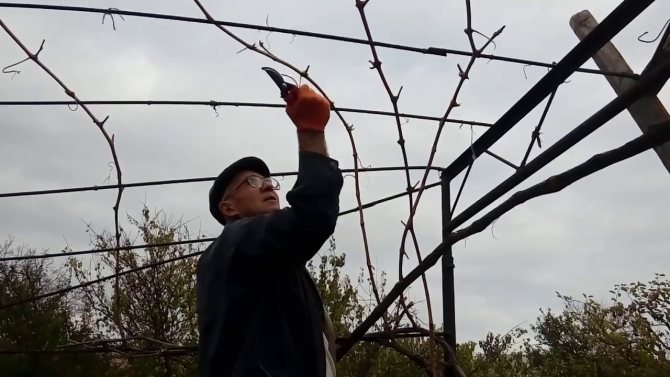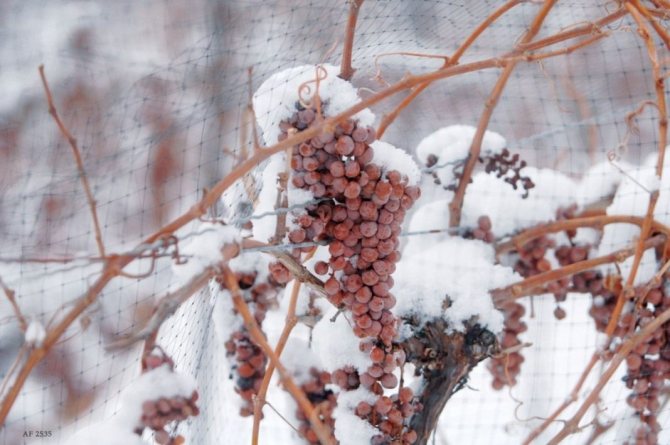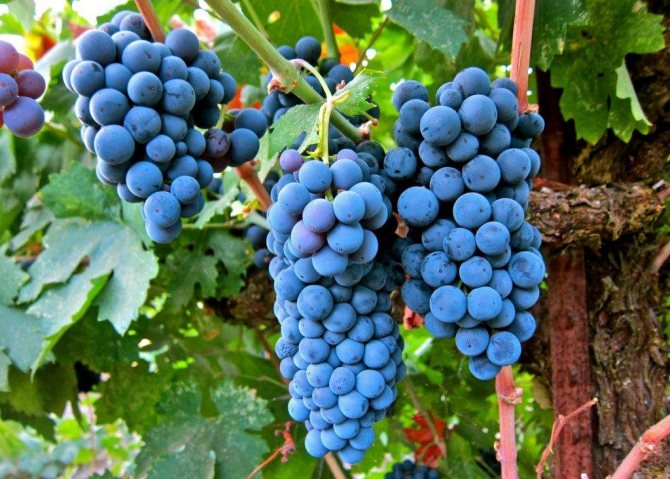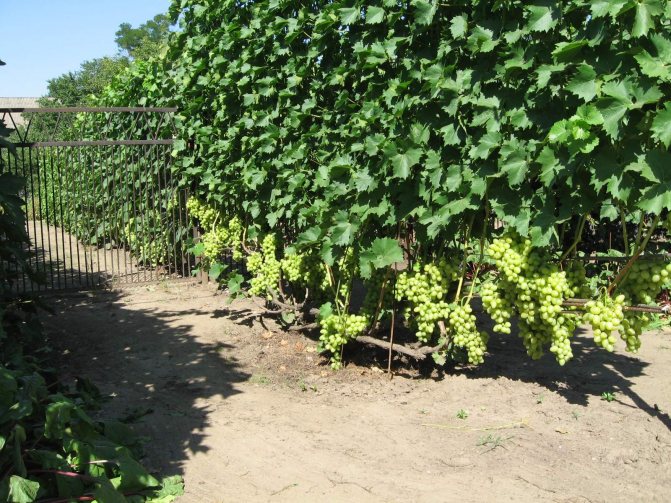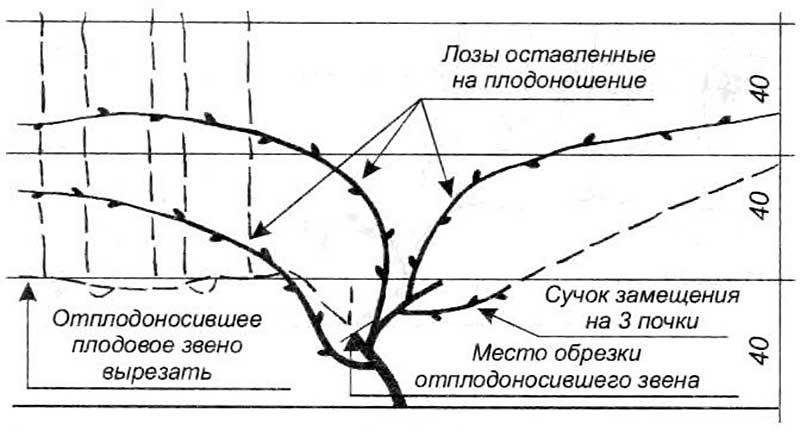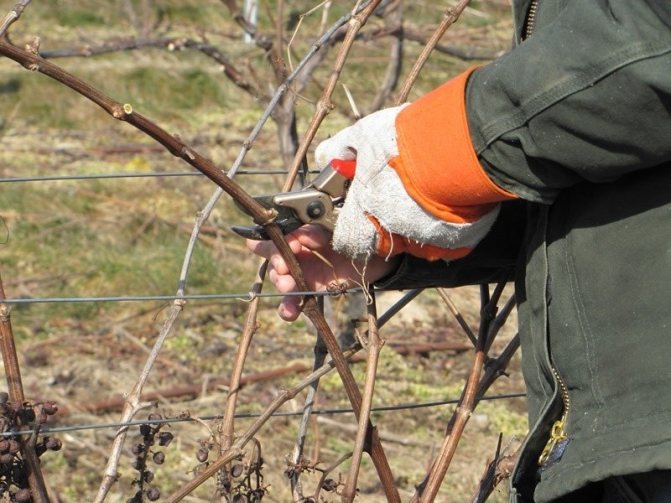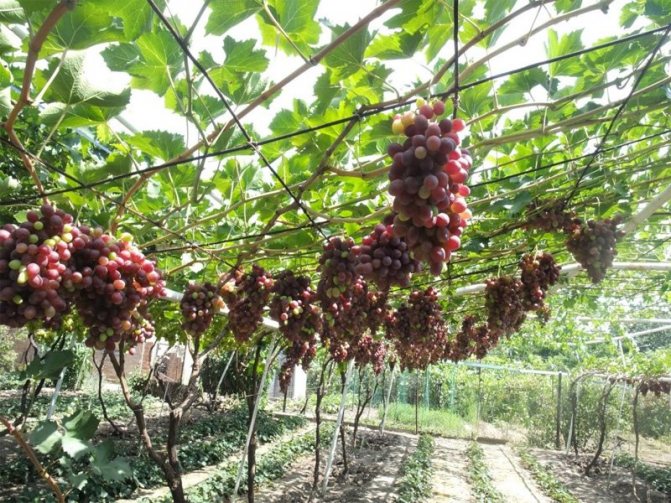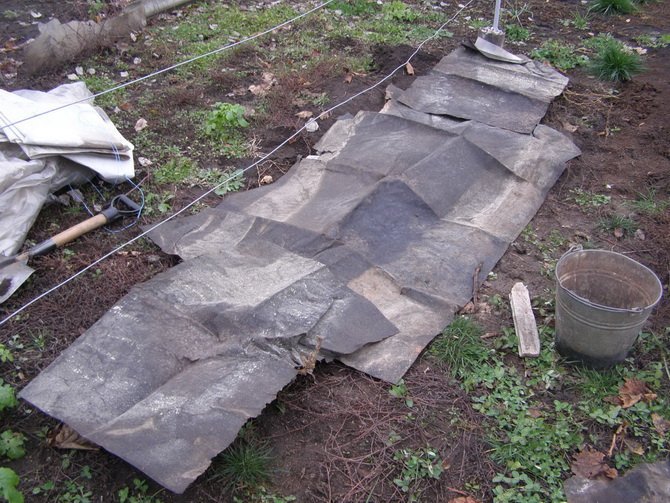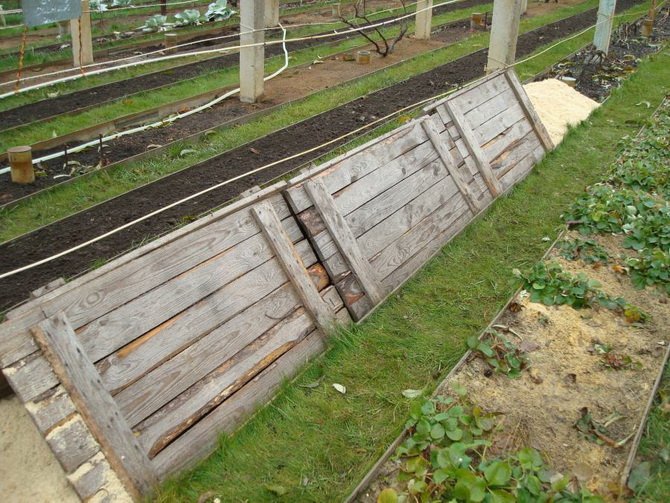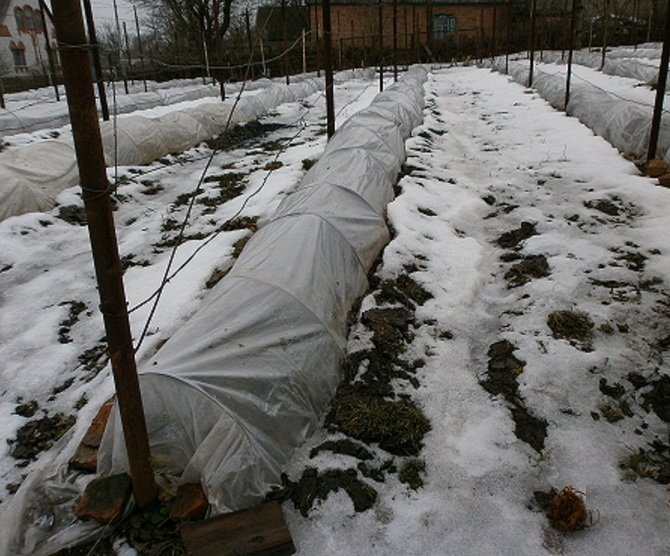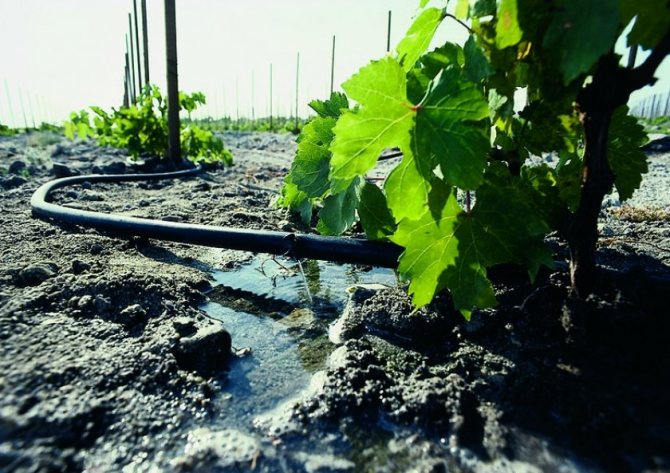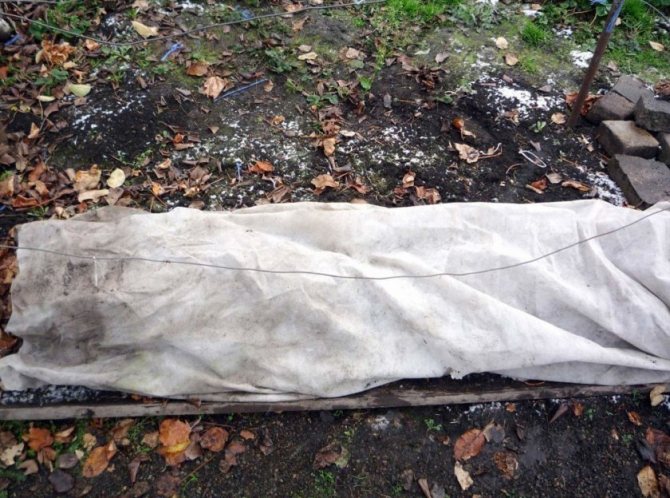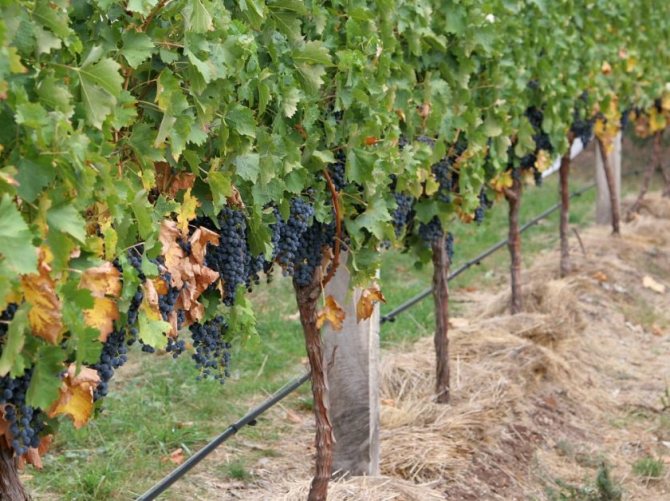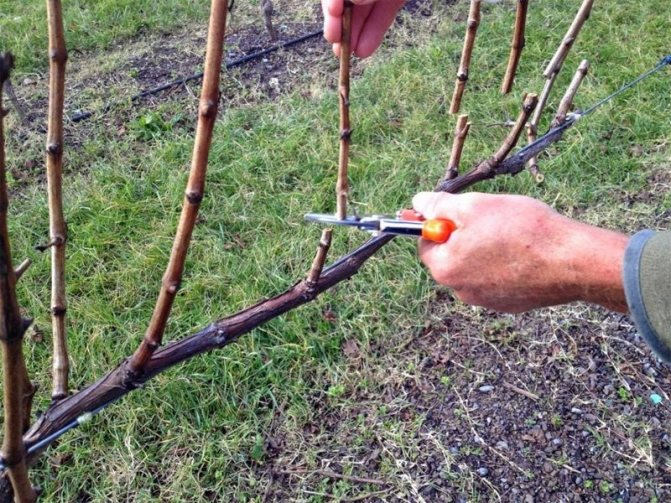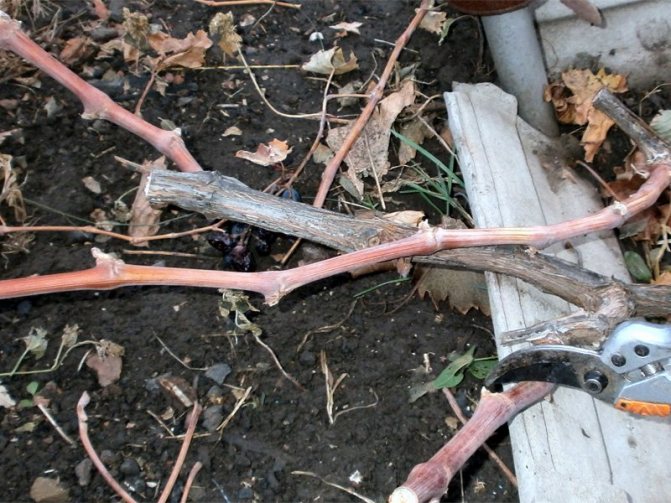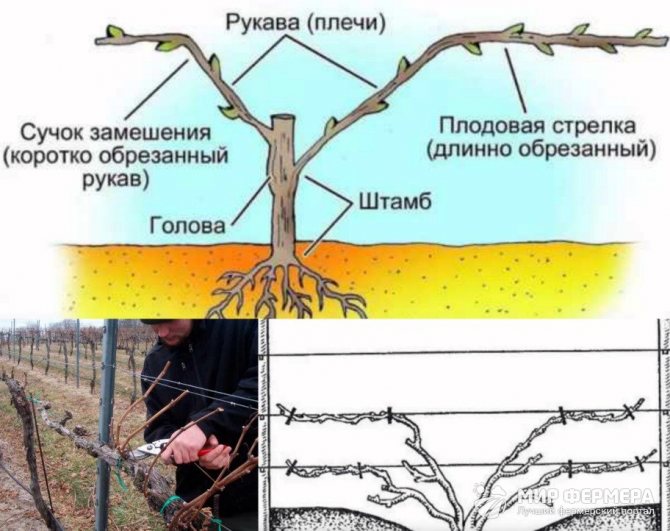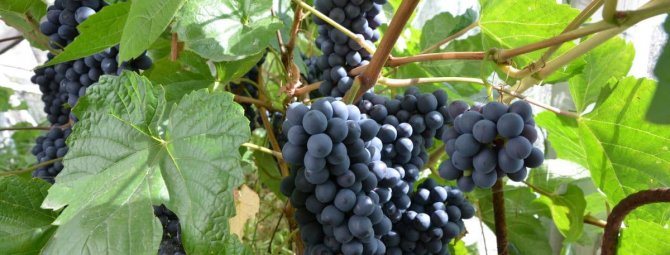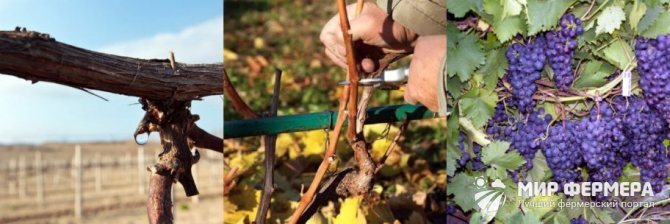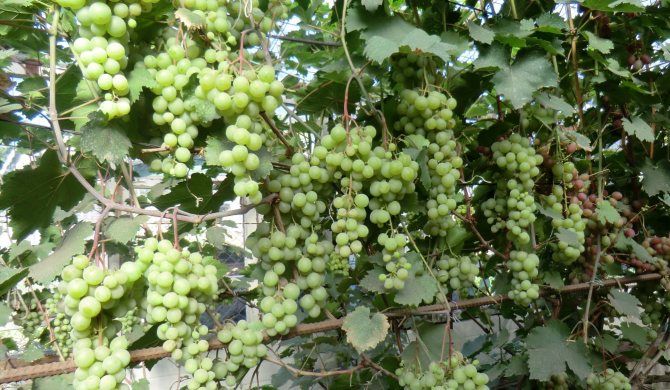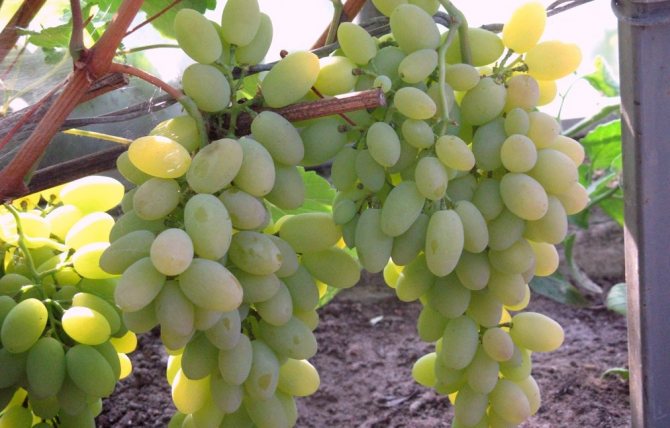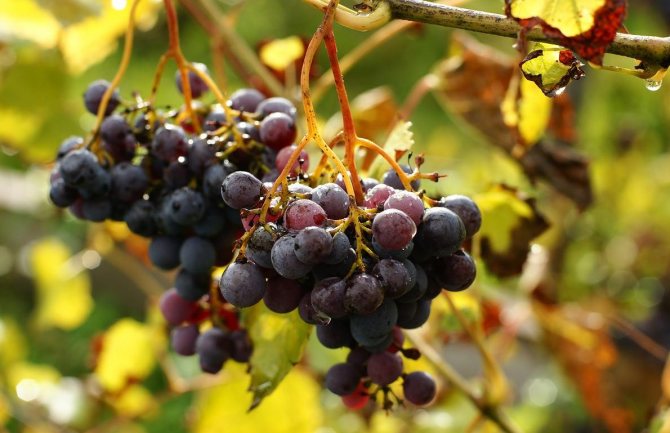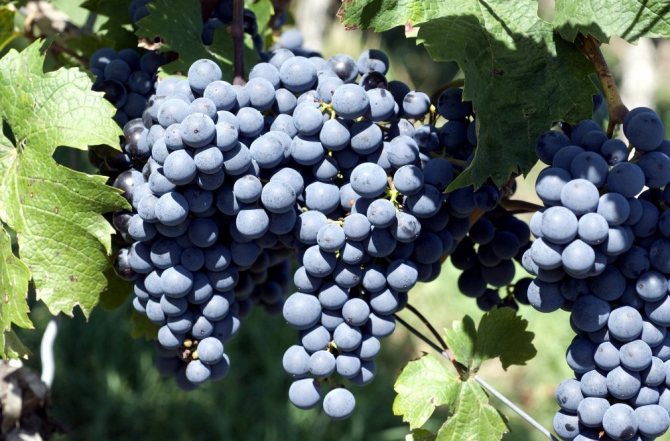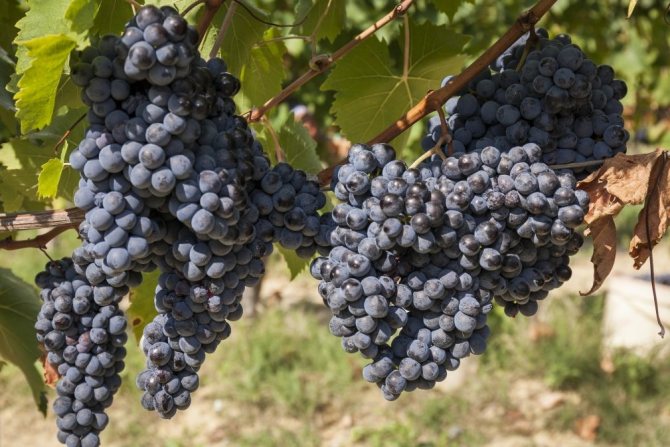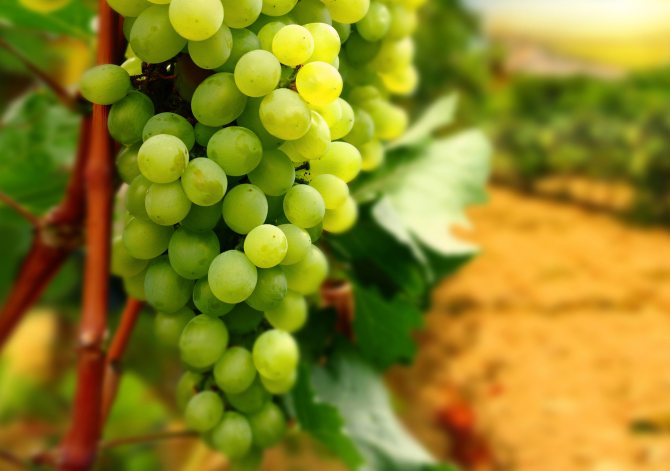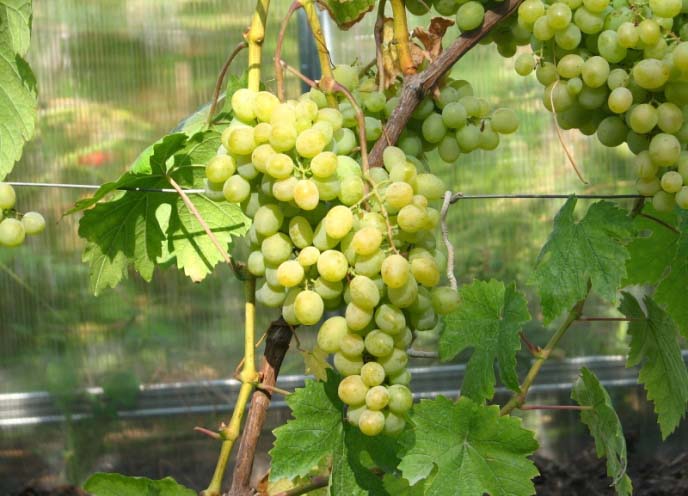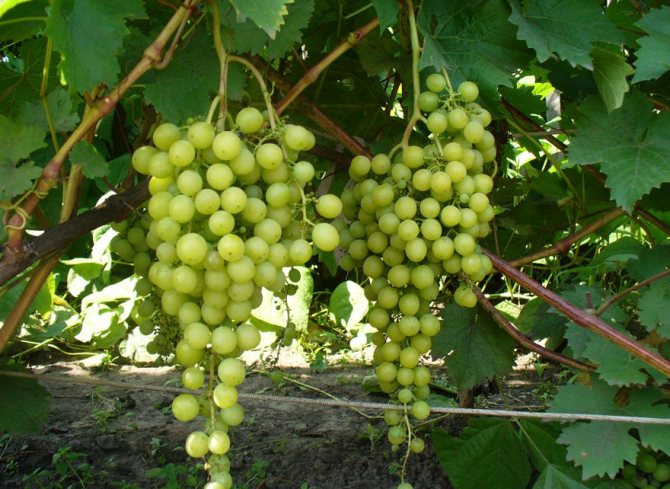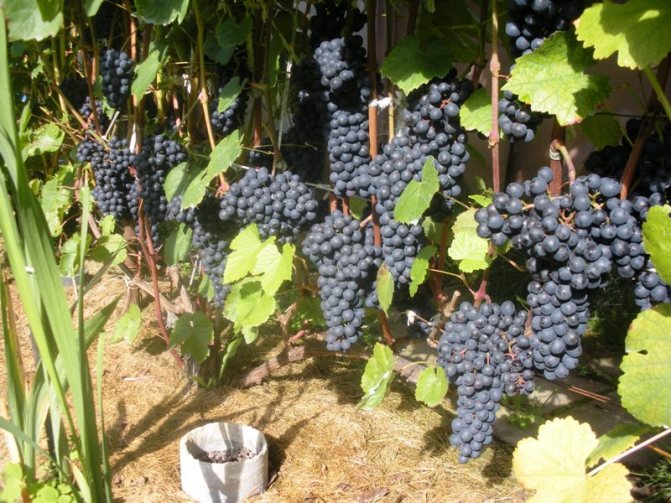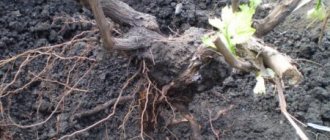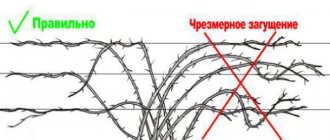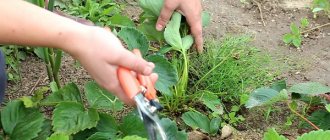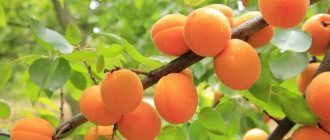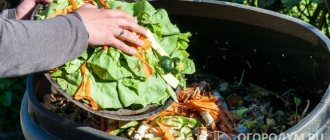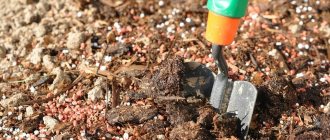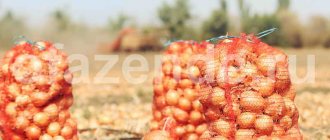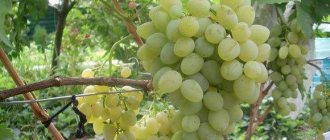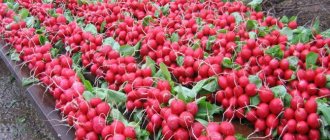Fruits and berries »Grapes
0
847
Article rating
The grape is a southern plant. Thanks to the work of breeders who managed to breed frost-resistant varieties, this plant is successfully grown in Siberia and other regions with a harsh climate. Correct pruning of grapes in Siberia is important in order for the harvest to be generous.
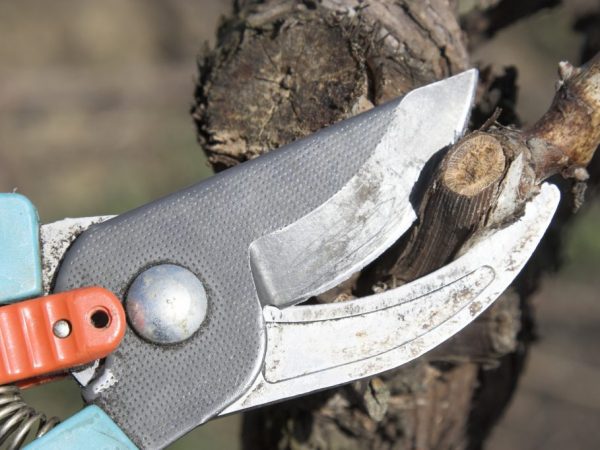
Pruning grapes in Siberia
Preparation for growing grapes in Siberia
If you want to grow grapes in Siberia, then the planting and care instructions for beginners, which we will give below, will come in handy.
1. It all starts with choosing a site for growing grapes. Since the sun does not please the cold edge, then choose the most illuminated place. It is also important that it is protected from the wind. Avoid low-lying areas due to the possibility of frost and fog. An excellent solution would be to grow grapes near the fence or next to the wall of the house. Remember that you do not need to look for a new place every spring for grapes: it can delight you with its harvest on one site for more than twenty years.
2. To grow good grapes, it is important to take care of the soil. When the growing season occurs, the shoots grow very quickly, and without properly prepared soil and good nutrition, it will be difficult for the plant to survive. This means that the harvest may not be as large as planned.
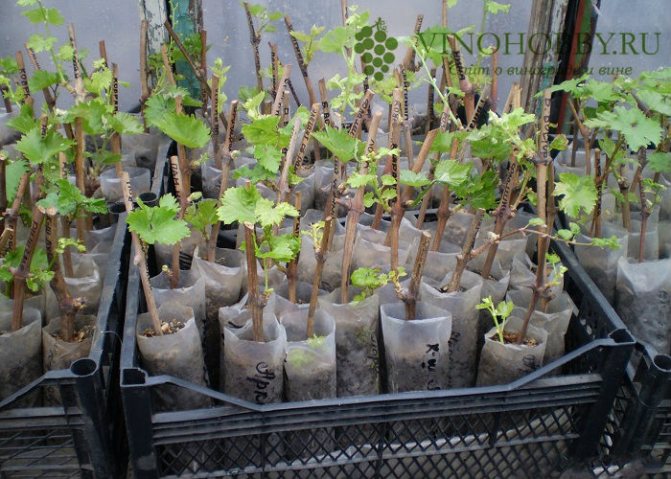

So, how to properly plant grapes in Siberia? Prepare the landing pits:
- You will need a trench thirty centimeters deep and eighty centimeters wide. Maintain a 2m distance between bushes.
- The first layer of mail is carefully dug up and set aside. It is important to fold the next layers in a different place.
- Dig a hole about sixty centimeters.
- Pour coal slag and superphosphate at the bottom of the pit.
- The next layer will be branches and weed.
- Add humus, sand, and topsoil to the pit.
- Fence in the trench. For this, both boards and plastic are suitable. Special fences can be purchased.
Stones and broken bricks can be used as drainage.
3. We wrote about lighting above, but we will repeat once again - the more light the plant gets, the better it will grow and bear fruit. 4. The ideal time for planting grape seedlings will be in late April or early May.
About the time of planting grape seedlings in the Siberian region
The Siberian Federal District is divided into 12 regions, each of which has its own climatic characteristics. Siberia is conventionally divided into three parts:
- northern (north of the Krasnoyarsk Territory, Dolgano-Nenets and Evenk regions);
- eastern (Republics of Buryatia and Tyva, Irkutsk region, Trans-Baikal Territory, south of Krasnoyarsk Territory);
- western (Republics of Khakassia and Altai, Altai Territory, Novosibirsk, Kemerovo, Tomsk and Omsk regions).
The easiest way to grow grapes is in the western territories, and the eastern ones are also suitable for early ripening varieties. Most of the grape varieties, specially bred for cultivation in the Siberian climate, ripen within three to four months.
Western Siberia
Has a continental climate. The average temperature of the winter period is from -15 ° С to -30 ° С. The snow cover reaches a thickness of 15-20 cm. In summer, the temperature varies from 15 ° C to 35 ° C.Western Siberia has the mildest climate, since the Altai mountains close the territory from the winds from Kazakhstan, and the Vasyugan swamps soften the heat in summer. In order to grow grapes in Siberia, it is very important to choose the right varieties specially bred for harsh climatic conditions.
Eastern Siberia
It is characterized by a sharply continental climate. The average temperature throughout the year is 0 ° C. Winter temperatures drop to -40 ° C, but the absence of winds softens the cold. The usual thickness of the snow cover is 20-25 cm. Summer is very sunny, with occasional rain, but the temperature does not rise above 15 ° C.
North
These territories are characterized by the most severe climate - this is practically a real tundra. There is almost no summer period, the air temperature above 10 ° C lasts less than 1 month. Winter is quite long and frosty. The temperature can easily drop below -40 ° C. Snow cover in the mountains and northern parts does not melt during the year.
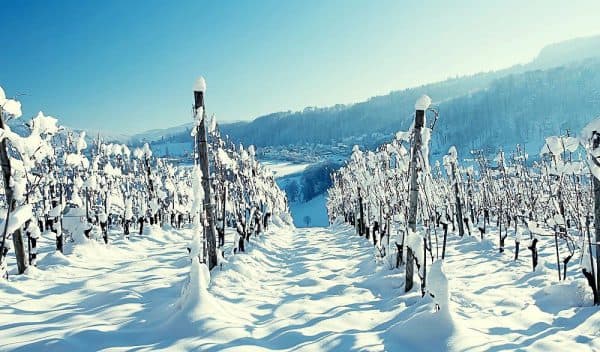

The harsh climate of Siberia does not allow growing the entire range of varieties of world selection.
1) North - this includes the Krasnoyarsk Territory (in the northern part), the Evenk and Dolgano-Nenets districts;
2) Eastern - this includes together with the rep. Buryatia and Tyva, the southern part of the Krasnoyarsk Territory and the Trans-Baikal Territory, Irkutsk Region;
3) Western - this includes together with the rep. Altai and Khakassia, Novosibirsk, Tomsk, Omsk, Kemerovo regions and Altai Territory.
It has become known empirically that the western territories of Siberia give the greatest harvest of grapes. Early ripening varieties are most suitable for the eastern territories.
The main varieties special for the Siberian Territory give grapes in 3-4 months.
In western Siberia, with its continental climate, with winter temperatures ranging from minus 15 to minus 30, the height of the snow cover can reach up to 20 centimeters. And the summer sun can heat the air up to 15 35C. The climate here is milder, because with the help of the Altai mountains, this zone is closed from the Kazakh wind, and with the help of the Vasyugan swamp, the summer heat is softened. For this part of Siberia, the right varieties are selected, suitable for such a difficult climate.
In eastern Siberia, with its sharply continental climate at an average annual temperature of zero, and in winter - up to minus 40, the height of the snow can reach up to 25 cm. The winter cold is softened by calm. And in summer, despite a good number of sunny days and rare rains, the temperature regime is no more than 15 degrees.
Northern Siberia is the harshest climatic territory typical for the tundra. Summer is practically absent, freezing temperatures can last for 30 days at best. In winter, the air can cool down to minus 40! In mountainous areas, snow lies throughout the year.
- at home, seedlings are placed in water to start the growing process;
- shorten the roots to 0.1 m;
- cut the vines to two or three eyes, and also remove the dried and frozen part of the seedlings;
- the roots are soaked in heteroaunsine or sodium humate (solutions), water for the solution is taken at a temperature of 25-30 degrees;
- the prepared roots, after soaking, are dipped in a clay mash;
- fully prepared seedlings are planted in open soil.
- weeding of plantings from weeds;
- rare watering;
- feeding;
- order in the aisle (periodic mowing of grass);
- there is no need to treat harmful insects, since they are almost all absent.
Mulch
The use of mulch will not be superfluous in the grape business. This is any material that covers the ground: grass, moss, hay, straw. They are also called the clothes of the earth.
Such a layer helps to retain moisture in the earth so that the lower layer has time to rot and the upper layer can dry out.
It is the mulch that prevents sudden temperature changes from affecting the roots. And when the cover decays, it will release carbon dioxide, which is an element of photosynthesis.
They begin to lay mulch only in the heated ground in the spring. By the autumn period, it will completely rot and give the earth humus.
Grape planting scheme
How to plant grapes if a plant planted in Siberia can die due to the wrong technology? First, it must be prepared and then proceed directly to the planting process:
- If you bought seedlings back in March, and you kept them in small cups, then transplant them into larger pots. Keep them on a windowsill until the warm season begins.
- When the air temperature begins to warm up to twenty degrees, take the plant outside for a while. Start at an hour and gradually work up to full daylight hours.
- After that, start planting. Water the seedlings well a day or two before planting.
- Plant the grapes in the prepared hole.
- Sprinkle earth on top and sprinkle with plenty of water. In one hole - a bucket of water.
How is the bush formed?
When you have just planted a seedling, you need to tie it up. To begin with, a stake or any stick of a meter height can act as a support.
When the first stepsons appear, pinch them. It is better to do this not at the very base, but after the second leaf. Many growers believe that this improves the process of photosynthesis.
In mid-August, the crown of the largest vines can be shortened.
How to form a bush from two vines:
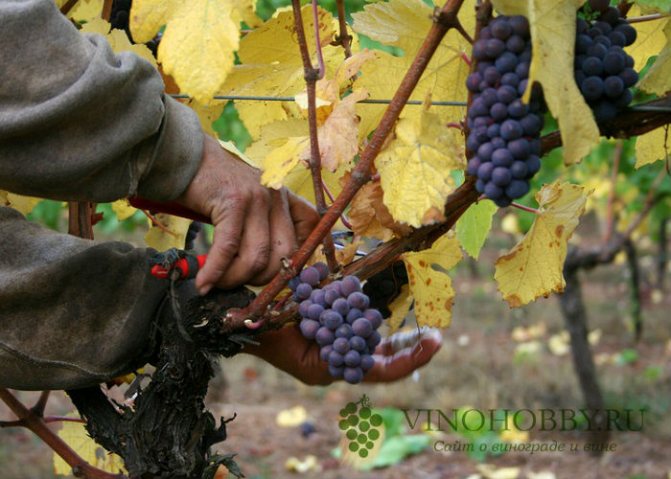

- In the autumn, you need to cut one shoot into four buds, and the second shoot into two.
- In the spring, support them on the trellis in a horizontal manner. And those sinuses that are just beginning to grow, place them vertically.
- For the next fall, each long shoot (of four buds) must be cut into two equal parts. Then they need to be shortened: at the center by two buds, at the edges by four.
- The next spring, those vines that will bear fruit are tied up horizontally, and the knots are left in an upright position.
Further watering the plant
Grape care in Siberia is a complex of measures and the most important part of it is watering. And although the grapes are not afraid of heat and drought, it still needs to be watered. How do you know when it's time to water it?
Pay attention to the leaves - if they become lethargic and sag a little, then the grapes can be watered. This will require about ten liters of water.
It is important not to skip watering during these periods:
- When the buds just blossomed.
- Two weeks before the plant begins to bloom.
- After flowering in one to two weeks.
- Before covering the grapes for the winter.
Pruning Siberian grapes
If in the first year of life the grapes gave only one shoot, then with the onset of autumn it must be cut by two.
Experts do not advise pruning in the spring, as the grapes are just beginning to gain juice and the "wounds" inflicted will not heal well. In the worst case, he may die completely.
Related article: Articles on viticulture, grapes
In early June, clusters may already begin to appear. Leave the bottom ones and cut the top ones. If you leave everything, then they simply will not have time to fully ripen.
Having understood the principle of the Siberian viticulture system, you will be able to independently make decisions and prune grapes in different ways. This will help you figure out which method is right for your plant to get a big harvest.
Fertilization and hardening of varieties
In particular, the care of grapes in Siberia also includes the correct fertilization and hardening of the bush.
Nitrogen fertilizers are not suitable for the maintenance of grapes in the area. Since, apart from the growth of leaves and vines, they do not give anything.
It is better to choose mineral and potash fertilizers, as they help to replenish the nutrients that are gone. They are fed twice during the whole season in a foliar way and always in a soluble form.
The bush can be sprayed with a wood ash extract.
Remember that grapes will take oxygen, hydrogen and carbon from natural sources - water and air. And the rest you need to provide it: phosphorus, calcium, potassium, magnesium, sulfur, boron, manganese, zinc, copper and iron.
Autumn pruning of grapes: advice from Nikolai Sergeev
Adding an article to a new collection
Gardeners often have many questions about caring for grapes: when to prune, how many sleeves should be left, how many vines. To get answers, we decided to contact a professional in this area - Nikolai Sergeev from Yuzhnouralsk, Chelyabinsk region.
Nikolay Georgievich Sergeev - An experienced winegrower, presenter of TV programs: "Advice to Gardeners", "Garden Head", author of a number of articles, films on gardening and special issues: "Grapes in every northern garden" and "Grapes in Siberia and the Urals."
Nikolai Georgievich is also the organizer of the site "Grapes of the Northern Latitudes of Russia" and the author of the books: "Reasonable Gardening" and "Home Vineyard", where you can find out a lot of useful information on the care of grapes and not only. At the moment, Nikolai Sergeev grows more than 200 varieties of grapes and is happy to share his experience with our readers.
Nikolai Georgievich, why do grapes need to be cut in autumn?
In the fall, after the first frost, it becomes clear what was able to prepare for wintering and what was not. If the trees prepare in advance for winter, stopping the growth of shoots, then the grapes continue to grow rapidly until the very frost. True, in this case, the vine also prepares for the cold: it removes water, becomes woody, and the shoots take on a brown or yellow color. It is believed that the grapes are ready for wintering when the crown of the vine (the folded tip of the shoot) is unbent. In our conditions, this practically never happens. It remains bent until the autumn frosts. This suggests that the grapes have not adapted to the conditions of the north, continue to grow and are not going to stop growing.
The pictures show how the vine is preparing for wintering. And the lower the daily temperatures, the faster the vine grows woody. This process stops with autumn frosts.
How to cover a bush for the winter?
When you have harvested from Amur grapes, maiden grapes or any other variety, you must immediately start protecting the bush from the first cold weather:
- Lay a film, a bag on the ground and remove the vines from the support.
- Place them on a bag or plastic wrap.
- Build a tunnel-shaped shelter like a greenhouse on top. To create it, you need polycarbonate.
- This will help the leaves of the plant not to freeze when the first frosts begin, and if the autumn weather in Siberia pleases the Indian summer, then photosynthesis and bud growth will continue in the grapes.
- After the leaves fall off, the structure must be disassembled. At the same time, leaving a film or bag on the ground.
- Start building a new shelter. It will look like a box with sides. Do not forget to leave space for the grapes between the walls so that it can breathe.
- Insulate the sides of the shelter with any suitable material: burlap or cardboard. You can also use Styrofoam and Spunbond.
- Put the film on top so that no water gets inside. For better protection from moisture, you will need slate.
During wintering, the plant should not touch metal objects. Otherwise, the kidneys may die.
When spring comes, the protective structure can be removed. This usually happens in mid-April. Don't wait for the soil to thaw and lift the vines.
After that, you need to make the same structure as in the fall - like a greenhouse.
You can start a garter only after a stable warm temperature is established and the likelihood of cold weather decreases.
Grapes in Siberia for beginners: planting and care
Among the gardeners of Siberia, the opinion has long been formed that growing grapes in large volumes is a risky and ungrateful business. There are many reasons for this:
- The harsh climate with cold winters and abrupt changes in average daily temperatures does not allow plants to overwinter. Saplings freeze out, all the costs of beginners are useless.
- Plants that have successfully wintered suffer from spring frosts. Delicate buds do not stand up and the gardener is left without a crop.
- Even if full-fledged clusters ripen on the bushes, early autumn frosts destroy summer growth.
You should not try to grow grapes using agricultural techniques of the southern regions, which did not give any results. Winegrowers have developed special frost-resistant varieties suitable for the harsh conditions of Siberia and a special technology for growing this thermophilic crop.
The first successes were achieved by agronomists from the Altai Territory. Here they learned to get a good harvest and began to cultivate new varieties with excellent taste characteristics, berries of various shapes and colors. The gardeners of Khakassia, Novosibirsk, Kemerovo and Omsk regions achieve excellent results.
New varieties with excellent taste characteristics
Based on this positive experience, gardeners have developed a reliable system of Siberian viticulture.
The best varieties for Siberia
Frost-resistant varieties are the best choice for growing in the Siberian climate. The list of varieties with this characteristic is very extensive. The following varieties are popular among winegrowers in Siberia.
- Thumbelina. A bisexual high-yielding variety with early middle ripening periods. The bunches become ripe by the end of August. The fruits are blue. The application is universal.
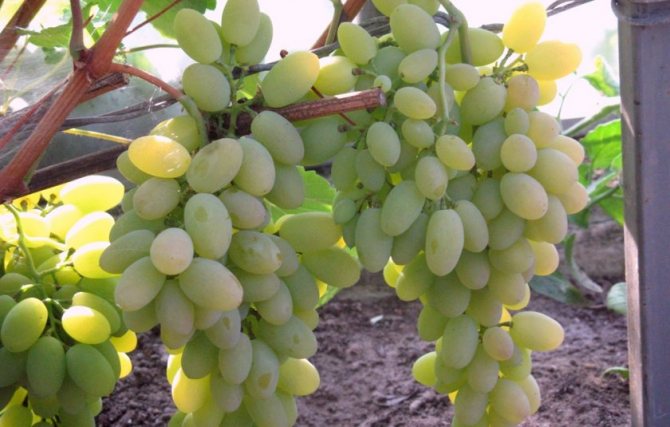

- Memory of Dombkovskaya. The variety is distinguished by its early ripening period. Seedless berries of dark blue color. In addition to frost resistance, it tolerates drought well. Without additional shelter, it can survive the winter frost down to -27 ° C.
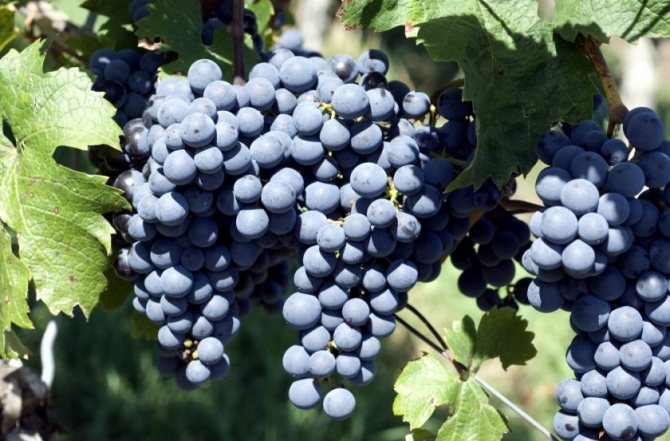

- Siberian cherries. The fruits are sweet, the skin color is dark blue. The variety is early, so the harvest can be taken in the first decade of August. Flowers are bisexual. Appointment canteen.
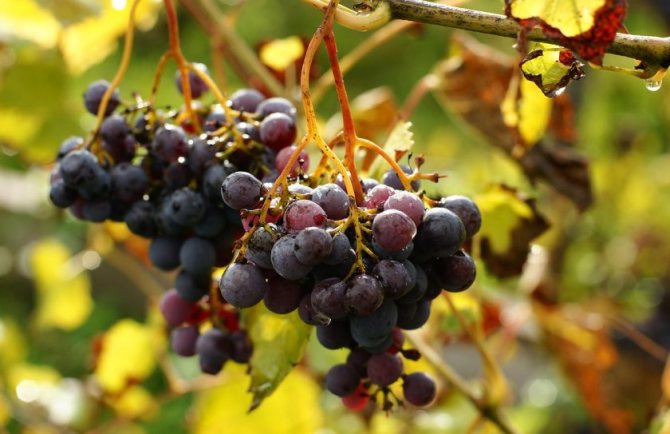

- Rusven. High-yielding early variety with pink berries. Cuttings take root quickly and often bear fruit as early as the next year after planting.
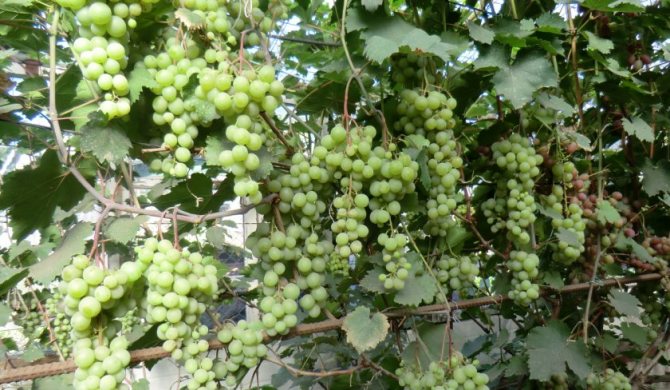

- Sharov's riddle. A versatile variety that can withstand frosts down to -34 ° C. The berries are dark blue with a rich sweet taste.
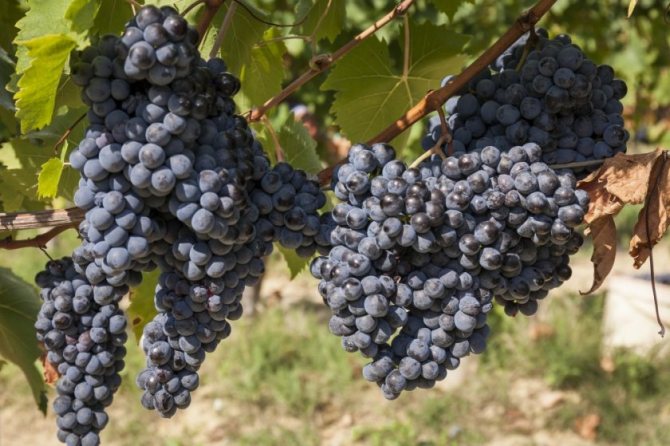

- Tukay. An early ripening table variety. The color of the berries is light, there is a nutmeg aftertaste. Winter hardiness up to -25 ° С.
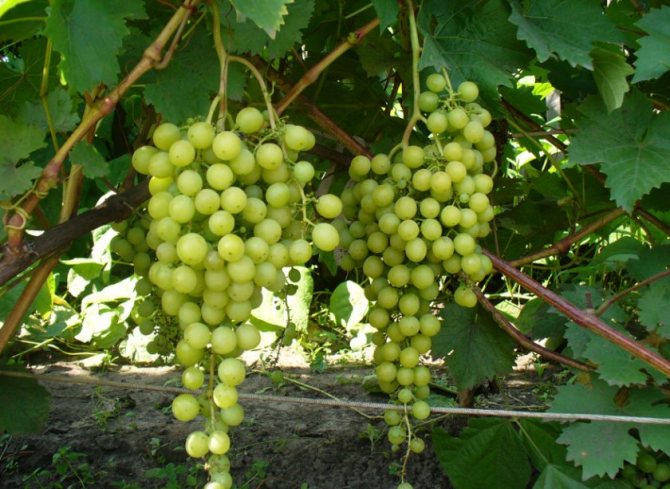

How to choose a place for grapes
To make the seedlings feel good on the site, choose a suitable open place:
- in winter, there should be a lot of snow in the vineyard, which will additionally cover the plantings. In the spring, water should quickly leave this place.
- in lowlands, plantings will die when groundwater rises or from cold moist air;
- in summer, plantings should be illuminated and sufficiently ventilated throughout the day;
- vines grow well against the walls of the house or near fences on the south or southeast side.
Important! With proper care, grapes grow in one place and give full yields for 15-20 years.
How to prepare the ground
In summer, the vine grows 5-10 cm per day. It is necessary to provide adequate nutrition for this.
If seedlings are planted without preparation in the ground, nutrients from the upper layer are quickly consumed. Because of this, the growth of plants stops and fruits cannot be expected from them.
With the onset of warm days, pits are prepared for future plantings, drainage is provided and the necessary microelements are introduced.
How to prepare a landing site:
- A trench 80 cm wide is dug to a depth of 30-40 cm. An additional hole 60 cm deep is dug under each bush in the trench, following the scheme: 2 meters between bushes and 3 meters between rows. In total, a depth of 90 - 100 cm is obtained.
- The top layer of soil is removed on a shovel bayonet, laid on one side, and the rest of the earth on the other.
- At the bottom of each pit, drainage is made from gravel, a shovel of wood or grass ash and a glass of superphosphate mixed with the ground are added. The soil with fertilizers is covered with branches, rough grass.
- The deposited topsoil, sand and humus are mixed (in a ratio of 1: 1: 0.5). Pits are filled with this mixture to the level of the bottom of the trench and left for 2-3 weeks.
- The walls of the trench 30 cm high are reinforced with boards or any other material in the form of a box.
With this preparation, the earth will have time to warm up well and the nutrients will be enough for many years without additional feeding.
For your information! To maintain the soil between the bushes in proper condition, the aisles are sown with green manure. This will help redistribute the required elements and accumulate humus. With the onset of flowering, green manures are cut, crushed and used for mulching.
Winter preparation and shelter
The grapes are cut in autumn, laid and covered before the onset of severe frosts in layers:
- light dry shelter (cover the roots of young plants with cardboard or non-woven fabric, weak and newly planted young plants),
- then - the frame (if there is no trench),
- on top - insulation,
- then - the film.
If there is a trench, then it is covered with durable material (boards, shields), on top - insignificant insulation and film (or other moisture-proof material).
When to remove cover
Without artificial heating, the soil temperature at a depth of more than 25 cm is insufficient for good development of the root system. Covering the vineyard with a film in early spring (due to the remnants of snow) makes it possible to accumulate 300–400 ° C more active temperatures. If there are many sunny days, this will increase the heating.
- In the spring, the shelter is removed on April 15–25, the bushes are ventilated and covered with foil. The temperature under the film should be no more than 30–35 ° С.
- The film is removed on June 5-10, with a shoot length of 80-100 cm.
- You can not remove the film shelters all summer long, but only raise and ventilate the plants. Convenient film greenhouses.
Planting grapes for beginners in spring in Siberia
They begin to disembark when the time of frost has passed and the earth warms up to 12-15 ° C.
Pre-prepared pits are spilled with hot water and covered to ripen the ground.
It is better to plant grapes in the evening at sunset or on cloudy days to avoid sunburn.
Saplings that hibernated in the basement or in the cellar, before planting, are examined, removed, dry and damaged. The roots are shortened, leaving no more than 25 cm. 5-6 buds are left on the stems. Plants are soaked in warm water, adding sodium humate or heteroauxin, then dipped in a mash made of two parts of clay or earth and one part of fresh mullein.
Grapes in Siberia
Select soil from the prepared pits and make a mound at the bottom. The roots are distributed along the entire length and carefully covered with earth, leaving a small depression. Sprinkle on top with any mulch.
Related article: Cytokinins
If a vegetative seedling is planted, that is, a sprout in a pot, they try not to damage the clod of earth.
Landings are covered as long as there is a threat of cold snaps, and shaded from the sun.
If the trellises are not ready, a stake is placed next to the bush and the shoots are tied vertically. So the vines grow well, it is convenient to care for them. Pour 1-2 buckets of water into each pit. Water the next time when the top layer dries.
When grapes are covered
It is necessary to cover the plants during the period when the average daily temperature is kept within the range of -5 ° C, in other words, when the soil is already properly frozen and it is simply not possible to stick a shovel into it. That's when the grapes are covered with insulating materials: tops, bags of tyrsa, dry foliage, etc., and covered with moisture-proof materials on top.
Do not forget that the buds on grape bushes can withstand frosts down to -17 ° C, but the roots of plants can be affected already at -8 ° C. Therefore, the roots also need to be given due attention. Snow is a good cover.
The thicker the snow layer in the region, the thinner the insulation layer is needed for shelter. The thing is that a centimeter of snow is able to keep the temperature by 1 ° C. If there is a lot of snow in the region, then it is enough to cover the plants with a waterproof material.
Grapes in Siberia for beginners: planting and care
Watering the grapes is not often, but abundantly, depending on the condition of the soil. Light sandy soils are watered more often, and heavy clay soils - less often.
Seedlings do not need additional feeding, but in the fall you can add phosphorus and potassium under the bushes. This contributes to better preparation for winter and accelerates the maturation of the wood.
It is not necessary to prune the grapes in the first two years, but immediately leave one or two strong branches. By the end of August, pinch the growth points and remove the shoots that did not have time to woody.
Pruning
For beginner gardeners, pruning is considered the most difficult procedure. It is enough to master simple rules to perform manipulations.
The grapes are pruned in two stages:
- Unripe, damaged, weak shoots and fertile vines are cut out after harvest. The plant will direct all its strength to prepare for winter.
- Before the onset of frost, the branches are prepared for future fruiting.
The crop is laid on one-year-old shoots. To do this, choose a strong branch and form a fruit link: one long fruiting shoot with 6-12 buds and a replacement knot with 2-3 buds. From the buds on a long shoot, the harvest grows the next year, and from a short knot - 2 young shoots, with which they do the same: one is cut into 6-12 buds, and the other - into 2-3 buds.
On a note! The future harvest depends on the number of fruit links.
The stronger and older the bush, the more links are left:
- in the first 2-3 years, the plants are allowed to grow freely, but 3-4 strong shoots are immediately left, the rest are broken;
- in the first year of fruiting, 20 eyes are left on the bush;
- in the second year, 40 eyes are left;
- in the third year - 60 eyes;
- in the fourth year - 80 eyes;
- after the fifth year, up to 150 eyes are left.
Novice growers are advised to remove the extra bunches when the result of pollination is visible. The number of bunches depends on their size and the characteristics of the variety. On large-fruited varieties, one bunch is left for the shoot, and on every third shoot, all the ovaries are removed. On other varieties - 1-3 clusters per shoot.
1-3 clusters per shoot
On average, 1 kg of berries are obtained from one shoot.
Preparing for winter
In late autumn, when the grapes have thrown off the leaves, the vines are laid horizontally and covered with a film or covering material to extend the growing season. With the onset of stable cold weather, a dry, windy day is chosen and finally sheltered for the winter:
- check that the plants are dry;
- covered with sawdust, husks, needles;
- cover with film and any materials at hand;
- shields of boards, slate, roofing material are placed on the ditch;
- sprinkle with earth on top;
- make sure that no water gets into the shelter, the vines do not spill out during a sharp warming.
Grape varieties not requiring shelter
There are grape varieties that do not require shelter, which are enough to bend down and make sure that there is enough snow on top.
With the onset of warm days, you can dig out the ground and remove the shelter, but do it gradually, avoiding a sharp change in temperature.
The vines will remain under the film until the threat of frost is gone. Then you can remove the film, lift and tie the shoots to the trellises. Cut and burn moldy, rotten branches.
Note! If suddenly the shoots died from unexpected frosts, the affected fragments are cut off and the plants are intensively fed with nitrogen fertilizers and any manure or bird droppings. We will have to say goodbye to the harvest this year.The overgrown shoots are pinched, not allowing them to grow strongly, and in the fall everything unnecessary is cut out.
Formation of grapes in the third year
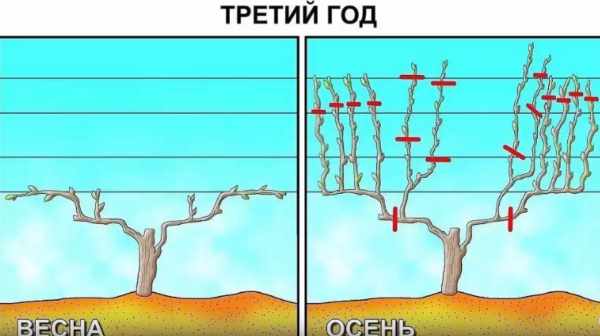

In the spring, after the frost has passed, they remove the shelter from the vine. Tie long fruit arrows to the bottom wire of the trellis horizontally, with the tops in opposite directions.
Replacement knots
leave to grow vertically. During the summer, stems will grow from all the buds. At the beginning of August, carry out chasing - cutting the stems by 10-20 cm. This will increase the quality and quantity of berries.
Do not mint before August, otherwise a lot of shoots will appear on the vine.
In autumn
, after falling leaves, cut off the last 4 vertical shoots with a part of the sleeve.
As a result, one link with two vertical shoots will remain on each shoulder. Prune them in the same way as in the second year. Cut off the shoot closest to the center, leaving 2 buds, leaving 4 buds for the distant ones.
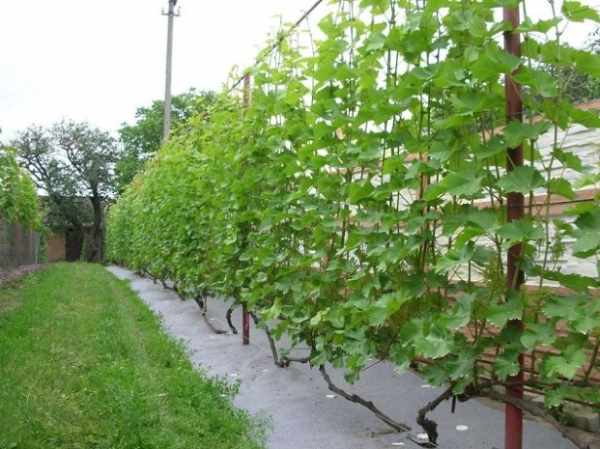

All subsequent years of growth of the grape bush, carry out pruning in the same way as in the third year.
Attention: for greater reliability and stock, more buds can be left on the shoots, but no more than 10 on each. This is done in case of frost damage.
For example, the optimal number is 3 buds on replacement knots and 6-7 buds on fruit arrows. In the spring, if all the kidneys survived, the extra ones can be cut off.
Video - Grapes Pruning a bush
Here are the main secrets for pruning grapes in the fall, the observance of which will be the key to obtaining a high-quality and large harvest of berries.
Siberian grape varieties
Even with the observance of all agronomic norms and rules, it is not easy to achieve results if the wrong grape variety is selected. For Siberia, special frost-resistant early varieties have been bred that can withstand up to -40 ° C and give a crop.
Tukay
High-yielding variety. The berries ripen in 100 days.
It grows strongly in width, gives large yields, requires rationing.
Delicious amber-green fruits with dense skin are collected in large clusters up to a kilogram in weight.
Solovyova-58
By the end of summer, it has time to ripen. Whitish fruits have a strawberry-nutmeg taste, are suitable for fresh consumption, are used for wine and juice. Bunches weighing 200-300 g.
Grapes are always rooted, do not freeze and are not susceptible to disease. The bush is compact. It is necessary to ration the harvest and avoid a heavy load.
Memory of Dombkovskaya
Vigorous vigorous bushes with carved dark green leaves. The berries are large, black in color, ripen by the beginning of September. The bunches are large, loose. The variety is resistant to diseases and frost.
Sharov's riddle
A widespread variety in the gardens of Siberia. The fruits ripen at the end of August. Berries are dark blue, large, with juicy fragrant pulp, collected in medium-sized clusters. Cut bunches are stored for a long time.
Codryanka
The high-yielding variety is resistant to diseases, withstands frosts down to -22 ° C, ripens in 3 months. The berries are large, up to 8 g, purple in color and pleasant to the taste. The brushes are large, weighing up to 1.5 kg.
About 80 hybrids and varieties were bred for the Siberian region. When purchasing seedlings, they pay attention to growth, resistance to diseases, winter hardiness, size, taste and color of berries. It is safer to buy planting material in specialized nurseries.
The Vorontsovs' nursery in Novosibirsk has established itself well, there are nurseries in Barnaul, Krasnoyarsk, Irkutsk ... You can take cuttings and seedlings from experienced gardeners. You cannot buy grapes from random sellers. There is a danger of taking infected plants or unsuitable for the local climate.
It is not easy to grow grapes in Siberia, but if you follow the recommendations of experienced gardeners, you can achieve harvests no worse than the southern ones. The following principles must be followed:
- choose only zoned varieties of local selection;
- provide regular feeding and watering;
- make sure that the plants do not freeze in winter and do not vomit during warming;
- harden grapes for resistance to temperature extremes;
- ration the harvest, avoid overloading the vine;
- carry out autumn pruning in two stages.
Taking care of grapes in spring in Siberia will not cause any special problems. Even in Siberian conditions, you can grow a decent harvest.
Brightening cropping
It is necessary to clear the bush of unnecessary shoots, twigs, some foliage. Provide access to sunlight to the branches so that they have time to mature properly before the onset of cold weather. This event is held in the fall, after the first frost, from 15 to 25 September.
Especially the first pruning is needed if the summer turned out to be relatively cold or varieties with poor maturation of the vine are grown.
After harvesting, the top of the grape bush is cut, green shoots and stepchildren are removed. Then the branches are untied from the trellises and carefully placed in the aisle. After that, you need to carefully examine the plant, and remove crooked and weak branches, antennae, remaining stepsons, remove dead foliage from the bottom of the bush.
Such pruning is done for seedlings over three years old. Only the top is cut off to one-year-old bushes, and stepsons and tops are removed for two-year-old seedlings.
For frost-resistant varieties, it makes no sense to prune in two stages. The vine and the harvest have time to ripen well, so pruning is done at one time, after harvest. This period is from September 20 to October 15.
Features of viticulture in Siberia
The cultivation of grapes in Siberia is carried out according to 2 schemes. First rules:
- storage of seedlings is carried out in protected, frost-free buildings;
- planting pits are deeper than in the southern regions, with the exception of soils with a high groundwater occurrence;
- the garter is carried out with the onset of stable heat: at the time of frost, the bushes are covered with rags;
- in summer, minimize garter and shaping;
- exclude feeding and treatment with fungicides: there are no pests in cold regions, and the culture is protected from diseases by removing weeds and fulfilling elementary agrotechnical requirements;
- the formation of a bush of a heart-ray shape is carried out on a vertically located wire trellis;
- the increase in pressure on the buds and branches during pruning is made 2 times higher compared to that inherent in the southern technique.
The second system does not involve grafting for frost-resistant varieties. Chubuki of the required length is prepared in the fall and stored in the basement or with a covered parent specimen. Planting holes are not dug on chernozem soils. Loosening, fertilization, fungicide treatment are excluded. Pruning is carried out once a season, before preparing for the winter.
Features of the structure and names of parts of the vine
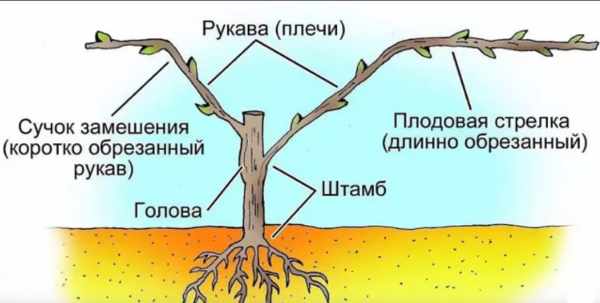

The base of the trunk, which is underground, is called heel
, roots grow from it.
Stam
- part of the stem up to the first lateral shoot, as in all trees. In grapes, part of the stem is also underground, ending with the heel.
Head
- a thickening on the main stem, from which lateral shoots extend.
Sleeves (shoulders)
- these are lateral shoots extending from the main stem. And the eyes on them are the same kidneys.
Read also: Is it possible to freeze chanterelles for the winter
There are terms to remember: fruit arrow and replacement knot.
Fruit arrow
- a long-cut sleeve, on which 8-12 buds are left after trimming.
Replacement knot
- short sleeve, after trimming, 2-4 eyes remain.
Fruit link
- a pair of shoots consisting of a replacement knot and a fruit arrow. We have sorted out all the names, let's move on to the secrets of pruning grapes.
Types of grapes for Siberia
The primary task is to select a hardy grape variety for Siberia. The southeastern exotic will freeze out in winter. Through trial and error, winter-hardy species have been selected that can adapt to abnormal cold weather. In Siberia, very early grape varieties are used: Valiant, Golden Key, Muscat, Amur, Kaya, Venus.
Mid-season species: White Savraska, Muromets, Alpha, Delight. Late-ripening varieties: Obskoy, Reline pink, Biysk-2, Lando Noir.
Seedlings are bought in specialized stores. When buying, the cuttings are examined for mechanical damage. The condition of the root system is assessed.
Disembarkation
Grapes in Siberia will not take root in the low-lying area, the northern hill, blown by the winds. It is better to plant the shanks in the southeast, or south of the site.
Grapes are planted in Siberia from north to south in order to ensure optimal uniform illumination of the sun from 2 sides.
It is better to find a place next to the outbuildings that protect the plants from the wind from the west. They refuse to plant grapes in swampy and high groundwater areas.
A large vineyard is planned in advance. To ensure good ventilation and illumination, a distance of 2.5-3 m is left between the rows.
Disembarkation dates
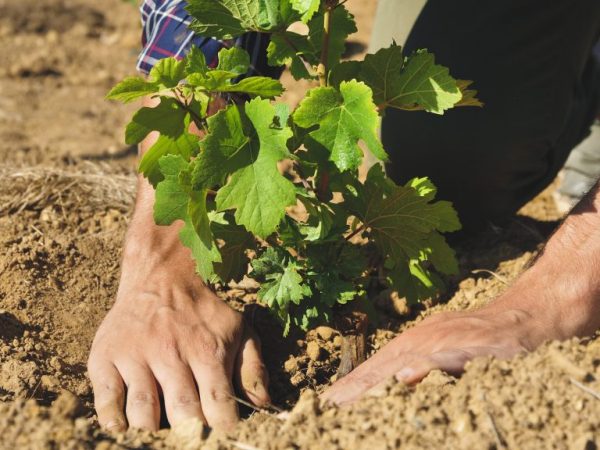

It is recommended to plant the plants at the end of May.
Grapes take root in Siberia much longer. The root system develops much more slowly than in the south. Vineyards in cold climates begin to be planted after a stable high temperature of at least 15 ° C is established.
The disembarkation time falls on the 2nd part of May. Landing is carried out on a cloudy quiet day or a calm evening. The bright sun will weaken the plants, and they will not take root well in the open field.
Preparation of seedlings
It will not work to grow grapes from seeds in Siberia. The plant will not be able to adopt maternal qualities, it will be weak and is unlikely to give full-fledged fruits. It is better to grow seedlings growing in peat glasses, or cuttings that have wintered for a year in a dry, frost-protected basement.
Preparation of grape seedlings in Siberia:
- the roots are cut to 10-12 cm;
- the vine is shortened to 2 buds;
- rhizomes are soaked in heteroaunsine or sodium humate, in accordance with the manufacturer's description;
- rhizomes are treated with a chatterbox made of clay and ash, planted.
Landing technology
How to properly plant grapes in Siberia:
- the depth of the hole is 1 m, the width corresponds to the dimensions of the rhizome;
- a layer of gravel is poured onto the bottom;
- install a plastic tube to ensure good aeration of the soil.
Part of the upper earth, dug out of the hole, is mixed with sand, organic matter, and a hill is formed on a layer of gravel. The roots are spread on a mound and sprinkled with soil. Having rammed, spill the earth with warm water.
Taking care of grapes in Siberia is much easier than in the southern regions.
Grapes for Siberian conditions are distinguished by their hardiness. It is customary to grow it using toughened technology. The seedlings are not fed. The main agricultural activity is pruning.
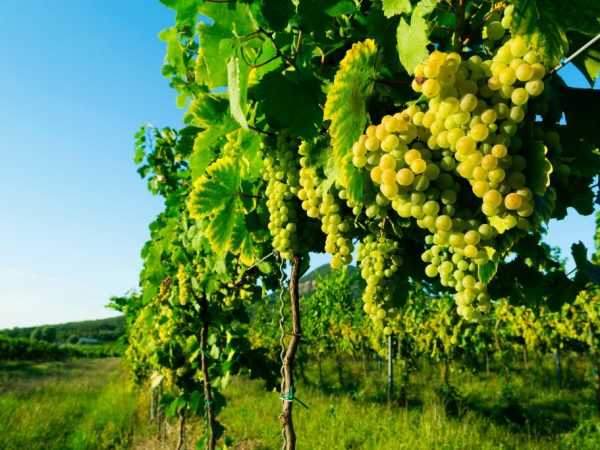

Plants are not difficult to grow
For 1 year of life, 2 powerful shoots are left on the plant. If the sprout originally had 2 shoots, the vine is shortened by 1 bud. The sprouting shoots are pinched on the stump. If the seedling contained 1 shoot, when it reaches a height of 60 cm, pinch the growth point to allow lateral branches to develop.
Pruning
Growing grapes in Siberia is not difficult for novice winegrowers. The main thing is to correctly form a bush in order to provide full-fledged development to fruiting shoots. The first pruning is carried out in late August and early September. Remove dry, damaged, weakened, fertile vine.
The second is done before preparing for the winter. To plant full-fledged grapes in Siberia, the second formation cannot be tolerated in the spring. The purpose of the procedure is to remove new fruiting shoots as the main ones. Leave 2 strong, adjacent sprouts with 10-20 eyes. The girlish is cut off, the man's is left long. In the summer, the maiden will form a crop, in the second - the shoots.
In the fall, the sequence of actions is changed. The girl's shoot is left long, the male shoot is cut on a stump. The process allows you to rejuvenate the bush and prevents the crown from thickening.
Load on plants
The vineyard in Siberia should not be overloaded. This is an important agrotechnical move that allows you to get a consistently high yield. The load is determined by the number of buds on the shoot, which subsequently give flowers. An increase in load reduces the quality of the crop, weakens the plant, a decrease - accelerates the growth of the deciduous part. Weak plants freeze and die in winter.
Early grapes for Siberian conditions for the first 2 seasons strengthens the rhizome, adapts in the open field. In the first fruitful year, 20 buds are left on the plant, in the second - 40, in the third - 60, in the fourth - 80. An adult vineyard includes plants with 150 eyes on each. The indicator is averaged. The orientation according to the load norms is reduced to the peculiarities of the variety: small-berry ones load more, large-berry ones - less.
Nodes and kidneys
Nodes - thickening of the stem, on which leaves, inflorescences, antennae and buds are formed. The distance between the nodes (internodes) is from 3-4 to 20 cm. The normal length is 5-8 and up to 12 cm (longer ones are not taken for reproduction).
Peephole (wintering bud) - a conglomerate of buds under one shell, consists of 1 central (almost always fertile) and 2-6 spare (can be fertile and sterile).
In the spring, 1 central and 1–2 spare buds develop (twins and tees are formed from them, which are usually removed). If the bush is very thinned out, fertile twins are left.
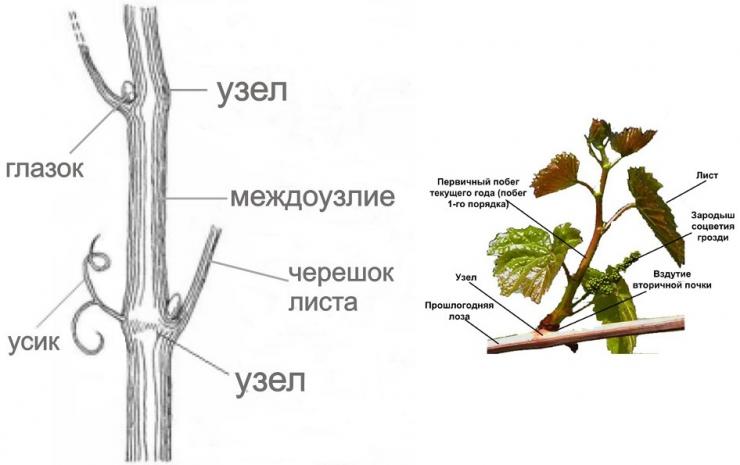

Photo: the structure of the vine shoot
Hardening
Care in Siberian conditions involves the adaptation of plants to the harsh climate. Plants are planted in open ground. Greenhouse shelters are not built. An exception to the rule that allows the construction of a temporary greenhouse: spring frosts occurred in the first winter of the plants on the site, and the shoots have not yet reached the growing point that allows them to be attached to the trellises.
Hardening allows you to accelerate acclimatization. Plants become more resistant to temperature extremes. Regular overexposure in the shelter will pamper the bushes. The specimens growing under cover produce crops and tolerate the season well, but freeze in winter.
Winter shelter
You need to take special care of the grapes in the pre-winter period. Preparation begins when the average temperature indicator per day approaches 0 ° C. At the time of organizing the shelter, the bushes are already cut off. The vine is removed from the fasteners and bent to the ground along a previously dug trench. The plant is carefully examined: it must be completely dry.
The vine is covered with rags, sprinkled with earth and covered with spruce branches. Grape bushes are sprinkled with fallen snow. The upper shelter is removed after its descent. The rags are removed during the activation of sap flow processes (in April). For shelter from night frosts, grapes are covered more easily.
Tips for beginners from experienced gardeners
When growing grapes, it is recommended to take into account the climatic special regions of Siberia and observe the following rules:
- Overloading the grape bush must not be allowed, you need to know exactly how you can load the vine with the harvest.
- A vine that is not tied to a trellis needs shelter in the spring, since spring frosts can destroy the plant.
- It is necessary to exclude a large application of nitrogen-containing fertilizers.
- In the spring, the shelter is removed. The timely opening of the plant in the spring will help to avoid damping off, and the gradual opening promotes hardening.
Competent vine care will allow you to get a high-quality grape harvest even in harsh climates.
Summarizing
Growing grapes in Siberia is affordable thanks to years of hard work on agrotechnical practices. Correct planting and minimal maintenance allow you to get high-quality crops that are not inferior in quality to the products of the south.
The cultivation of grapes in Siberia has its own characteristics and requires a thorough approach to the choice of varieties.It is better to grow early varieties on the site: such plants have more time to harvest nutrients for winter.
Sources:
Reviews and advice of Siberian winegrowers
It is very possible even in Siberia, and specifically in Altai, in Biysk there has been a school of winegrowers for a long time, and grapes have become widespread among amateur gardeners, even varieties of our Siberian selection have been bred. I have been dealing with grapes for a long time, Pearls, Sabo, Tukai, Aleshenkin, Katunsky Muscat are successfully bearing fruit, although only super-early and early varieties ripen in our country and shelter is required for the winter, but it is worth seeing the results of my labor.
Veniaminovich
No matter how lazy you are, in Siberia you still have to tinker with grapes (if the climate does not change). No matter how you accumulate heat, snow often falls in Siberia in late May - early June - in this case, if the grapes are not wrapped, they will freeze, and you may not wait for the harvest from the stepchildren - the summer is very short. There are also frosts in August, at the end - you also need to cover ... The ideal option is a greenhouse, as in the Baltics.
Buttercup
This season, on the night from 3.10 to 4.10 there was a frost of -4.5 o C. Adult bushes dropped their foliage - not critical, the vine is ripe. But the rows of seedlings (underyearlings) suffered. The shelter was trivial - inverted buckets - iron and plastic (I confess, I was too lazy to make arcs). The result is a grabbed vine. But the Pinot row was covered in arcs with 60 spunbond in two layers. The result is not a single speck on the leaves. I was very surprised, too big a difference. I use spunbond for the first time. Previously, he was distrustful of him as a winter shelter.
Mix_Servo
Growing grapes in Siberia is challenging but interesting. The main thing is to prevent the bushes from freezing in winter and to provide maximum amount of heat in summer. If bunches of ripe grapes appear on the vines, then all your efforts were not in vain. You can assign you the honorary title of winegrower, because not every gardener can successfully cultivate this crop, even in the south of the country.
Pruning grapes
- one of the most difficult activities in the country. Sometimes it's hard to figure out
how to properly prune grapes
and when.
Pruning a vine is reduced to pruning 90 percent of the vine, leaving the required number of eyes (buds).
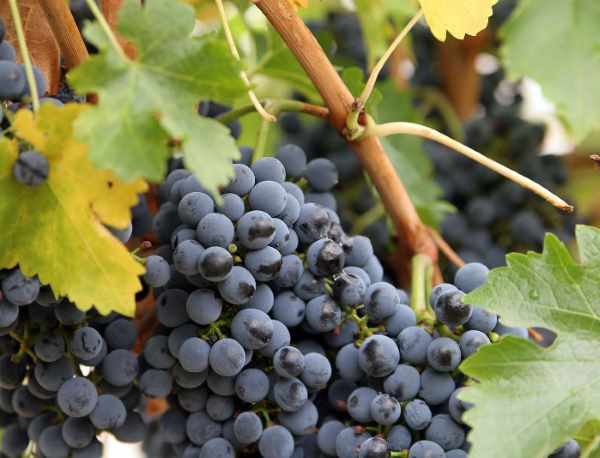

Let's consider in detail secrets of correct pruning of grapes
starting from the first year of planting.
Grape pruning can be done both in spring and autumn. When pruning in the fall, it is advisable to cover the bush for the winter, protecting it from freezing. If your area has harsh winters, prune in the spring or cover your vine for the winter. By the way, uncut grapes endure the winter better.

